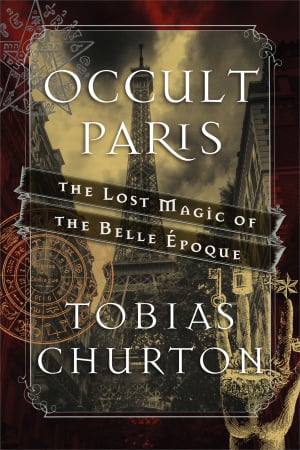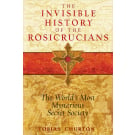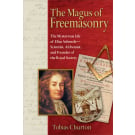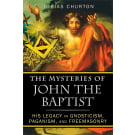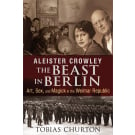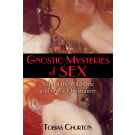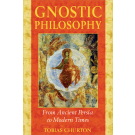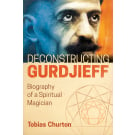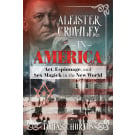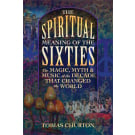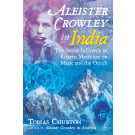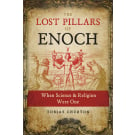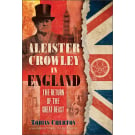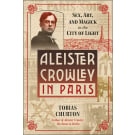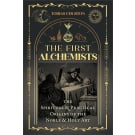Availability:
In Stock
- Pages: 528
- Book Size: 6 x 9
- ISBN-13: 9781620555453
- Imprint: Inner Traditions
- On Sale Date: November 3, 2016
- Format: Hardcover Book
- Illustrations: Includes 16-page color insert and 160 b&w illustrations
Historian Tobias Churton explores the magical, artistic, and intellectual world of the Belle Époque Paris. He brings into full perspective the personalities, and forces that made Paris a global magnet and which allowed later cultural movements, such as the “psychedelic 60s,” to rise from the ashes of post-war Europe.
How fin-de-siècle Paris became the locus for the most intense revival of magical practices and doctrines since the Renaissance
• Examines the remarkable lives of occult practitioners Joséphin Peladan, Papus, Stanislas de Guaïta, Saint-Yves d’Alveydre, Jules Doinel, and others
• Reveals how occult activity deeply influenced many well-known cultural movements, such as Symbolism, the Decadents, modern music, and the “psychedelic 60s”
During Paris’s Belle Époque (1871-1914), many cultural movements and artistic styles flourished--Symbolism, Impressionism, Art Nouveau, the Decadents--all of which profoundly shaped modern culture. Inseparable from this cultural advancement was the explosion of occult activity taking place in the City of Light at the same time.
Exploring the magical, artistic, and intellectual world of the Belle Époque, Tobias Churton shows how a wide variety of Theosophists, Rosicrucians, Martinists, Freemasons, Gnostics, and neo-Cathars called fin-de-siècle Paris home. He examines the precise interplay of occultists Joséphin Peladan, Papus, Stanislas de Guaïta, and founder of the modern Gnostic Church Jules Doinel, along with lesser known figures such as Saint-Yves d’Alveydre, Paul Sédir, Charles Barlet, Edmond Bailly, Albert Jounet, Abbé Lacuria, and Lady Caithness. He reveals how the work of many masters of modern culture such as composers Claude Debussy and Erik Satie, writers Arthur Rimbaud and Charles Baudelaire, and painters Georges Seurat and Alphonse Osbert bear signs of immersion in the esoteric circles that were thriving in Paris at the time. The author demonstrates how the creative hermetic ferment that animated the City of Light in the decades leading up to World War I remains an enduring presence and powerful influence today. Where, he asks, would Aleister Crowley and all the magicians of today be without the Parisian source of so much creativity in this field?
Conveying the living energy of Paris in this richly artistic period of history, Churton brings into full perspective the characters, personalities, and forces that made Paris a global magnet and which allowed later cultural movements, such as the “psychedelic 60s,” to rise from the ashes of post-war Europe.
• Examines the remarkable lives of occult practitioners Joséphin Peladan, Papus, Stanislas de Guaïta, Saint-Yves d’Alveydre, Jules Doinel, and others
• Reveals how occult activity deeply influenced many well-known cultural movements, such as Symbolism, the Decadents, modern music, and the “psychedelic 60s”
During Paris’s Belle Époque (1871-1914), many cultural movements and artistic styles flourished--Symbolism, Impressionism, Art Nouveau, the Decadents--all of which profoundly shaped modern culture. Inseparable from this cultural advancement was the explosion of occult activity taking place in the City of Light at the same time.
Exploring the magical, artistic, and intellectual world of the Belle Époque, Tobias Churton shows how a wide variety of Theosophists, Rosicrucians, Martinists, Freemasons, Gnostics, and neo-Cathars called fin-de-siècle Paris home. He examines the precise interplay of occultists Joséphin Peladan, Papus, Stanislas de Guaïta, and founder of the modern Gnostic Church Jules Doinel, along with lesser known figures such as Saint-Yves d’Alveydre, Paul Sédir, Charles Barlet, Edmond Bailly, Albert Jounet, Abbé Lacuria, and Lady Caithness. He reveals how the work of many masters of modern culture such as composers Claude Debussy and Erik Satie, writers Arthur Rimbaud and Charles Baudelaire, and painters Georges Seurat and Alphonse Osbert bear signs of immersion in the esoteric circles that were thriving in Paris at the time. The author demonstrates how the creative hermetic ferment that animated the City of Light in the decades leading up to World War I remains an enduring presence and powerful influence today. Where, he asks, would Aleister Crowley and all the magicians of today be without the Parisian source of so much creativity in this field?
Conveying the living energy of Paris in this richly artistic period of history, Churton brings into full perspective the characters, personalities, and forces that made Paris a global magnet and which allowed later cultural movements, such as the “psychedelic 60s,” to rise from the ashes of post-war Europe.
Three
Meetings with Remarkable Men
We can see that symbolic powers, occult powers, and poetic powers emerge from the same source, the same depths.
Gaston Bachelard, Preface to Richard Knowles’s Victor-Émile Michelet, Poète Ésotérique
During the 1960s and 70s, British historian Dame Frances Yates astonished and perplexed the community of historical scholarship by her reasoned advocacy of the view that a highly significant factor in promoting the genesis of modern science and its representative the “scientist” was the Renaissance Hermetic movement’s veneration for the Magus. The Magus is concerned with extending his powers over all aspects of creation, even unto immaterial realms. In analyzing the life of Dominican friar Giordano Bruno in particular (Giordano Bruno and the Hermetic Tradition, 1964), Yates demonstrated how the opposition of the Catholic Inquisition created the idea of Bruno as a “martyr to science”--he was burned at the stake in Rome in 1600 as an impenitent heretic--when his actual views were regarded in the main as superstitious claptrap by many 19th-and 20th-century scientists operating on “Newtonian” lines. Rekindled in Florence after 1460, Yates declared the gnostic “Hermetic Tradition” stimulated the rediscovery of Man as a free-willed Operator in the universe, a co-creator with the divine, to whom no secret need remain hid. [. . .] Thus “occult philosophy” was not in fact “hidden philosophy”--the deliberate cultivation of esoteric obscurity--but revealed what had formerly been hidden to the eyes of the fearful and the ignorant; in another word, science, but science with esoteric and spiritual balls: Gnostic science was the vehicle of revelation.
What is truly fascinating about developments in Paris in the 1880s and ’90s is that at the very time when many scientists had reached an apogee of materialist certainty verging on hubris--feeling themselves and their experimental methods utterly alien to the figure of the Mage who “dreamed but did not get real results”--yet at that very moment we find the Magus’s position as the desirable ideal and archetype being assumed not as the ideation of the scientist, but as the apotheosis of the ARTIST. The aim? That Art trump Science. New men will embrace the new religion, universal, already hidden in spiritual symbols, which, while the traditions and cultures around them might differ superficially, exist as one in essence.
Esotericism insists there is correspondence between all things. One thing opens a door to another: all rooms are connected. The new religion was at home in the Temple, whether of ancient Egypt, the Panthéon in modern Paris, or the contemplative mind in its study, or with like-minded friends. [. . .] In this religion, the Magus and prophet is not the scientist who limits the universe to measure it, but the Artist who seeks the infinite, the one who accepts the “open secret” of the universe as mystery. The Artist becomes one who reveals the hidden truth, not of matter itself, but of Man and the determinative occult world behind nature. Hail the Artist as custodian of spiritual being, of idealization, of beauty, of essential truth!
The dizzy heights of this realization were given verbal form in sweeping style by Bailly bookshop habitué Joséphin Péladan: “There is no reality other than God. There is no Truth other than God. There is no Beauty other than God.”3 Péladan deduced that the greatest art had necessarily been generated for the Catholic Church and the time had come for the Church to realize that the true hierophant of the mysteries was the Artist, the Magus come to the cradle of the Lord with gifts. [. . .] He was sacrificer and bridge-builder between the invisible and the visible, between this world and the world to come: the master of the ikon and of memory. The Artist’s business was with the ideal and the spiritual, not with reproducing the visual plane of nature like an ape. Paraphrasing Hermes Trismegistus, Péladan concluded: “Artist, you are Magus: Art is the great miracle.” The materialist scientist will only take you further into the endless darkness of matter, progressively enslaving the spirit to rational categories and destroying the divine humanity. The Magus, of whom Leonardo was a shining exemplar, combined search into the quantitative visible world with a no less penetrating search into the invisible and symbolic world, the infinite worlds, the boundless worlds of imagination, not to be confused with merely external fantasies as in the vulgar notion of “surrealism” or visual whimsicality. He was a man of imagination and his genius transcended his time, perhaps time itself.
So we see the figure of the Hermetic Magus return, and his gift was to justify the position of the artist, to secure him at the heights. [. . .] Hermetism made exalted sense of the Artist and his peculiar life and vocation. It thus became desirable for the new artist, who, like Redon, found the “ceiling” of the Impressionists too low for comfort to explore occult traditions, to partake more fully in the insights of the condemned gnosis. For this purpose, the L’Art Indépendant shop in the Rue de la Chaussée d’Antin and the Librairie du Merveilleux in the Rue de Trévise became essential calling points. In those oases of the ideal freedom, the movement could take its store of inspiration while sharing thoughts and carrying them out into the artists’ apartments, studios, informal salons, and café meetings. Now joined, Symbolism and Occultism shared mutual waves that would rise into an aesthetic flood, rolling through the streets of Paris in an attempt to sweep away the barricades of materialism, to oppose the Barbarians at home and abroad with unearthly Beauty and the power of the Spirit. After all the historic, failed revolutions that promoted what was perceived to be Paris’s decline into decadence, a spiritual revolution was afoot. Its weapon: ART, perceived as the exercise of the “High Science,” that is to say, Hermetic magic.
Meetings with Remarkable Men
We can see that symbolic powers, occult powers, and poetic powers emerge from the same source, the same depths.
Gaston Bachelard, Preface to Richard Knowles’s Victor-Émile Michelet, Poète Ésotérique
During the 1960s and 70s, British historian Dame Frances Yates astonished and perplexed the community of historical scholarship by her reasoned advocacy of the view that a highly significant factor in promoting the genesis of modern science and its representative the “scientist” was the Renaissance Hermetic movement’s veneration for the Magus. The Magus is concerned with extending his powers over all aspects of creation, even unto immaterial realms. In analyzing the life of Dominican friar Giordano Bruno in particular (Giordano Bruno and the Hermetic Tradition, 1964), Yates demonstrated how the opposition of the Catholic Inquisition created the idea of Bruno as a “martyr to science”--he was burned at the stake in Rome in 1600 as an impenitent heretic--when his actual views were regarded in the main as superstitious claptrap by many 19th-and 20th-century scientists operating on “Newtonian” lines. Rekindled in Florence after 1460, Yates declared the gnostic “Hermetic Tradition” stimulated the rediscovery of Man as a free-willed Operator in the universe, a co-creator with the divine, to whom no secret need remain hid. [. . .] Thus “occult philosophy” was not in fact “hidden philosophy”--the deliberate cultivation of esoteric obscurity--but revealed what had formerly been hidden to the eyes of the fearful and the ignorant; in another word, science, but science with esoteric and spiritual balls: Gnostic science was the vehicle of revelation.
What is truly fascinating about developments in Paris in the 1880s and ’90s is that at the very time when many scientists had reached an apogee of materialist certainty verging on hubris--feeling themselves and their experimental methods utterly alien to the figure of the Mage who “dreamed but did not get real results”--yet at that very moment we find the Magus’s position as the desirable ideal and archetype being assumed not as the ideation of the scientist, but as the apotheosis of the ARTIST. The aim? That Art trump Science. New men will embrace the new religion, universal, already hidden in spiritual symbols, which, while the traditions and cultures around them might differ superficially, exist as one in essence.
Esotericism insists there is correspondence between all things. One thing opens a door to another: all rooms are connected. The new religion was at home in the Temple, whether of ancient Egypt, the Panthéon in modern Paris, or the contemplative mind in its study, or with like-minded friends. [. . .] In this religion, the Magus and prophet is not the scientist who limits the universe to measure it, but the Artist who seeks the infinite, the one who accepts the “open secret” of the universe as mystery. The Artist becomes one who reveals the hidden truth, not of matter itself, but of Man and the determinative occult world behind nature. Hail the Artist as custodian of spiritual being, of idealization, of beauty, of essential truth!
The dizzy heights of this realization were given verbal form in sweeping style by Bailly bookshop habitué Joséphin Péladan: “There is no reality other than God. There is no Truth other than God. There is no Beauty other than God.”3 Péladan deduced that the greatest art had necessarily been generated for the Catholic Church and the time had come for the Church to realize that the true hierophant of the mysteries was the Artist, the Magus come to the cradle of the Lord with gifts. [. . .] He was sacrificer and bridge-builder between the invisible and the visible, between this world and the world to come: the master of the ikon and of memory. The Artist’s business was with the ideal and the spiritual, not with reproducing the visual plane of nature like an ape. Paraphrasing Hermes Trismegistus, Péladan concluded: “Artist, you are Magus: Art is the great miracle.” The materialist scientist will only take you further into the endless darkness of matter, progressively enslaving the spirit to rational categories and destroying the divine humanity. The Magus, of whom Leonardo was a shining exemplar, combined search into the quantitative visible world with a no less penetrating search into the invisible and symbolic world, the infinite worlds, the boundless worlds of imagination, not to be confused with merely external fantasies as in the vulgar notion of “surrealism” or visual whimsicality. He was a man of imagination and his genius transcended his time, perhaps time itself.
So we see the figure of the Hermetic Magus return, and his gift was to justify the position of the artist, to secure him at the heights. [. . .] Hermetism made exalted sense of the Artist and his peculiar life and vocation. It thus became desirable for the new artist, who, like Redon, found the “ceiling” of the Impressionists too low for comfort to explore occult traditions, to partake more fully in the insights of the condemned gnosis. For this purpose, the L’Art Indépendant shop in the Rue de la Chaussée d’Antin and the Librairie du Merveilleux in the Rue de Trévise became essential calling points. In those oases of the ideal freedom, the movement could take its store of inspiration while sharing thoughts and carrying them out into the artists’ apartments, studios, informal salons, and café meetings. Now joined, Symbolism and Occultism shared mutual waves that would rise into an aesthetic flood, rolling through the streets of Paris in an attempt to sweep away the barricades of materialism, to oppose the Barbarians at home and abroad with unearthly Beauty and the power of the Spirit. After all the historic, failed revolutions that promoted what was perceived to be Paris’s decline into decadence, a spiritual revolution was afoot. Its weapon: ART, perceived as the exercise of the “High Science,” that is to say, Hermetic magic.
Tobias Churton is Britain’s leading scholar of Western Esotericism, a world authority on Gnosticism, Hermeticism, and Rosicrucianism. An Honorary Fellow of Exeter University, where he is a faculty lecturer, he holds a master’s degree in Theology from Brasenose College, Oxford, and is the author of many books, including Gnostic Philosophy and Aleister Crowley: The Beast in Berlin. He lives in England.
". . . a massive, focused exploration of the relationship between the mystical and the creative. . .This entertaining volume will please fans of esoterica and the City of Light."
Publishers Weekly
“With Tobias Churton as the cicerone--or dare I say psychopomp?--the reader is expertly guided in the labyrinthine world of the Occult Paris of the Belle Époque (1871-1914). This is the best introduction to the French occult revival ever written in English.”
Henrik Bogdan, professor of religious studies at the University of Gothenburg
“Music, art, literature, mysticism--fin-de-siècle Paris had it all in great abundance, and in Tobias Churton’s latest tome he uncovers the hidden and not-so-hidden connections between Satie, Debussy, Redon, Rops, Khnopff, Gauguin, Crowley, Lévi, Papus, Mathers, Péladan, Michelet, Blavatsky, Reuss, Huysmans, Breton, and countless others. . . . Eminently readable and filled with meticulous historical details, this is a fabulous depiction of one of the most exciting and fervent periods of creativity in modern times.”
John Zorn, composer-performer
“A tour de force. A stunning account of fin-de-siècle Occult Paris and its lasting influence on the counterculture. . . . Churton gives comprehensive portrayals of such occult luminaries as Péladan, Papus, and de Guaita as well as a portrayal of their movements and a seminal analysis of esoteric art--in particular the ‘Rosicrucian’ art of the salons--locating its place in the intellectual, cultural, and political milieu of the Belle Époque. Tobias is as erudite as he is excited and exciting. His scholarship is alive with passion, imagination, humor, and, most of all, humanity. A must-read for students of European history, Art Nouveau, Symbolism, Idealism, Surrealism, and the Decadents as well as for neo-Rosicrucian, Templar and Gnostic esotericists, and modern-day alchemists and magicians.”
Stephen J. King (Shiva X°), Grand Master, Ordo Templi Orientis
“No one can evoke the feel of a place and an era like Tobias Churton! This is Paris in the Belle Époque, but behind the city of the can-can, Toulouse-Lautrec, and the Moulin Rouge, Churton shows us a Paris of seekers in mysterious worlds--magic, Hermeticism, Kabbalah, alchemy--and of artists, writers, and composers who were also drawn to those realms. The spirit of their compelling quest is stamped on every page of this book.”
Christopher McIntosh, Ph.D., author of Eliphas Lévi
“Tobias Churton brings this amazing era to life. Gnostics, Free Masons, Rosicrucians, Hermetics…The echos of Paris’ Belle Epoque is still heard in cultural and spiritual movements today.” The Echo
Publishers Weekly
“With Tobias Churton as the cicerone--or dare I say psychopomp?--the reader is expertly guided in the labyrinthine world of the Occult Paris of the Belle Époque (1871-1914). This is the best introduction to the French occult revival ever written in English.”
Henrik Bogdan, professor of religious studies at the University of Gothenburg
“Music, art, literature, mysticism--fin-de-siècle Paris had it all in great abundance, and in Tobias Churton’s latest tome he uncovers the hidden and not-so-hidden connections between Satie, Debussy, Redon, Rops, Khnopff, Gauguin, Crowley, Lévi, Papus, Mathers, Péladan, Michelet, Blavatsky, Reuss, Huysmans, Breton, and countless others. . . . Eminently readable and filled with meticulous historical details, this is a fabulous depiction of one of the most exciting and fervent periods of creativity in modern times.”
John Zorn, composer-performer
“A tour de force. A stunning account of fin-de-siècle Occult Paris and its lasting influence on the counterculture. . . . Churton gives comprehensive portrayals of such occult luminaries as Péladan, Papus, and de Guaita as well as a portrayal of their movements and a seminal analysis of esoteric art--in particular the ‘Rosicrucian’ art of the salons--locating its place in the intellectual, cultural, and political milieu of the Belle Époque. Tobias is as erudite as he is excited and exciting. His scholarship is alive with passion, imagination, humor, and, most of all, humanity. A must-read for students of European history, Art Nouveau, Symbolism, Idealism, Surrealism, and the Decadents as well as for neo-Rosicrucian, Templar and Gnostic esotericists, and modern-day alchemists and magicians.”
Stephen J. King (Shiva X°), Grand Master, Ordo Templi Orientis
“No one can evoke the feel of a place and an era like Tobias Churton! This is Paris in the Belle Époque, but behind the city of the can-can, Toulouse-Lautrec, and the Moulin Rouge, Churton shows us a Paris of seekers in mysterious worlds--magic, Hermeticism, Kabbalah, alchemy--and of artists, writers, and composers who were also drawn to those realms. The spirit of their compelling quest is stamped on every page of this book.”
Christopher McIntosh, Ph.D., author of Eliphas Lévi
“Tobias Churton brings this amazing era to life. Gnostics, Free Masons, Rosicrucians, Hermetics…The echos of Paris’ Belle Epoque is still heard in cultural and spiritual movements today.” The Echo
OCCULT HISTORY
During Paris’s Belle Époque (1871-1914), many cultural movements and artistic styles flourished--Symbolism, Impressionism, Art Nouveau, the Decadents--all of which profoundly shaped modern culture. Inseparable from this cultural advancement was the explosion of occult activity taking place in the City of Light at the same time.
Exploring the magical, artistic, and intellectual world of the Belle Époque, Tobias Churton shows how a wide variety of Theosophists, Rosicrucians, Martinists, Freemasons, Gnostics, and neo-Cathars called fin-de-siècle Paris home. He examines the precise interplay of occultists Joséphin Péladan, Papus, Stanislas de Guaita, and founder of the modern Gnostic Church Jules Doinel, along with lesser known figures such as Saint-Yves d’Alveydre, Paul Sédir, Charles Barlet, Edmond Bailly, Albert Jounet, Abbé Lacuria, and Lady Caithness. He also reveals how the work of many masters of modern culture such as composers Claude Debussy and Erik Satie, writers Arthur Rimbaud and Charles Baudelaire, and painters Georges Seurat and Alphonse Osbert bear signs of immersion in the esoteric circles that were thriving in Paris at the time. The author demonstrates how the creative hermetic ferment that animated the City of Light in the decades leading up to World War I remains an enduring presence and powerful influence today. Where, he asks, would Aleister Crowley and all the magicians of today be without the Parisian source of so much creativity in this field?
Conveying the living energy of Paris in this richly artistic period of history, Churton brings into full perspective the characters, personalities, and forces that made Paris a global magnet and which allowed later cultural movements, such as the “psychedelic 60s,” to rise from the ashes of postwar Europe.
TOBIAS CHURTON is Britain’s leading scholar of Western Esotericism, a world authority on Gnosticism, Hermeticism, and Rosicrucianism. An Honorary Fellow of Exeter University, where he is a faculty lecturer, he holds a master’s degree in Theology from Brasenose College, Oxford, and is the author of many books, including Gnostic Philosophy and Aleister Crowley: The Beast in Berlin. He lives in England.
During Paris’s Belle Époque (1871-1914), many cultural movements and artistic styles flourished--Symbolism, Impressionism, Art Nouveau, the Decadents--all of which profoundly shaped modern culture. Inseparable from this cultural advancement was the explosion of occult activity taking place in the City of Light at the same time.
Exploring the magical, artistic, and intellectual world of the Belle Époque, Tobias Churton shows how a wide variety of Theosophists, Rosicrucians, Martinists, Freemasons, Gnostics, and neo-Cathars called fin-de-siècle Paris home. He examines the precise interplay of occultists Joséphin Péladan, Papus, Stanislas de Guaita, and founder of the modern Gnostic Church Jules Doinel, along with lesser known figures such as Saint-Yves d’Alveydre, Paul Sédir, Charles Barlet, Edmond Bailly, Albert Jounet, Abbé Lacuria, and Lady Caithness. He also reveals how the work of many masters of modern culture such as composers Claude Debussy and Erik Satie, writers Arthur Rimbaud and Charles Baudelaire, and painters Georges Seurat and Alphonse Osbert bear signs of immersion in the esoteric circles that were thriving in Paris at the time. The author demonstrates how the creative hermetic ferment that animated the City of Light in the decades leading up to World War I remains an enduring presence and powerful influence today. Where, he asks, would Aleister Crowley and all the magicians of today be without the Parisian source of so much creativity in this field?
Conveying the living energy of Paris in this richly artistic period of history, Churton brings into full perspective the characters, personalities, and forces that made Paris a global magnet and which allowed later cultural movements, such as the “psychedelic 60s,” to rise from the ashes of postwar Europe.
TOBIAS CHURTON is Britain’s leading scholar of Western Esotericism, a world authority on Gnosticism, Hermeticism, and Rosicrucianism. An Honorary Fellow of Exeter University, where he is a faculty lecturer, he holds a master’s degree in Theology from Brasenose College, Oxford, and is the author of many books, including Gnostic Philosophy and Aleister Crowley: The Beast in Berlin. He lives in England.



